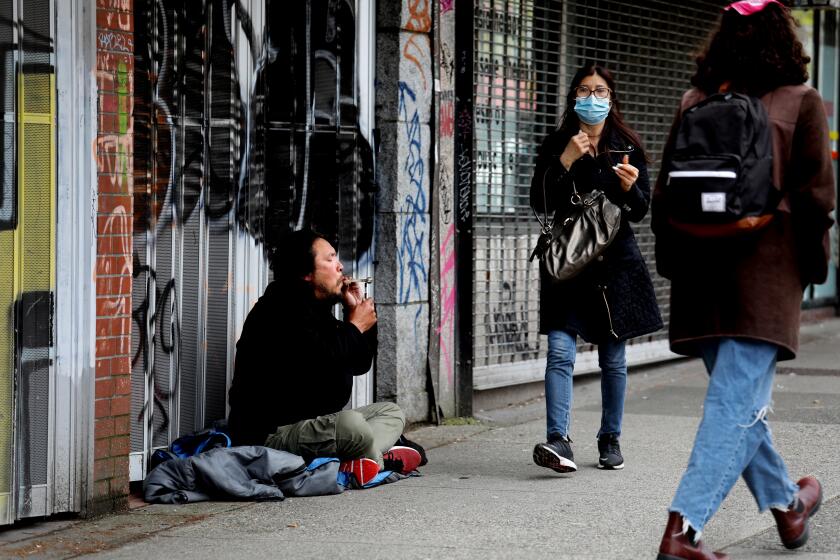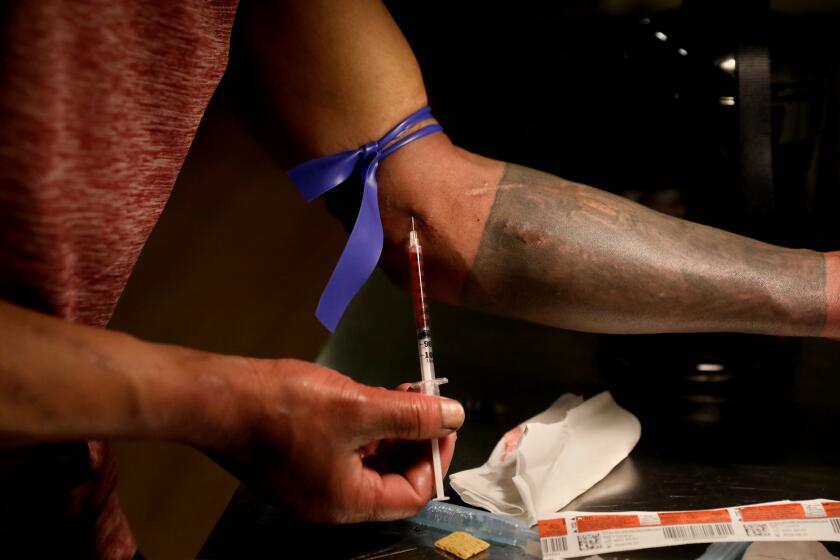Column: In San Francisco’s dystopian Tenderloin, the city goes rogue to slow drug overdoses

- Share via
SAN FRANCISCO — When people engage in illegal activity, they often try to hide it.
That’s been the case in San Francisco, where for months, city officials have quietly been running a safe drug consumption site — a violation of state and federal law.
The mysterious Tenderloin Center, as it’s known, includes a fenced-in patio obscured by tarps that blocks off part of a public square, across the street from a new Whole Foods. Here, with ineffective Swiss-cheese secrecy, the city has allowed addicts to use drugs while evading the truth publicly.
Media have been barred, despite repeated requests. Direct questions about whether guests were allowed to use drugs have received roundabout, wink-wink answers, with quick redirects to the bevy of other available services inside the adjoining building. Drugs? Let’s talk housing!
That stonewalling broke Thursday, when journalists including myself were allowed inside, albeit when the center was closed and there wasn’t much to see.
It was an overdue acknowledgement that the City by the Bay has gone rogue in its fight against a rising surge of overdose deaths — 38 in this neighborhood alone from January to April.
Though the furtiveness around the center led to mistrust and misinformation (and supercharged at least one political campaign based on a return to lock ’em up policies), it’s long past time that California got serious about stopping overdose deaths — even if it means asking forgiveness rather than permission.
Good job, San Francisco — in courage if not candor.
Vitka Eisen, the chief executive of Healthright 360, a nonprofit that is in charge of the overdose prevention area, told me (nervously) that up to 200 people a day come to use illegal drugs they have brought with them, though no buying or selling is allowed. About two-thirds of those are smoking — largely fentanyl but also crystal meth and heroin — while the rest inject.

More than 100,000 people died of overdoses in the U.S. last year, nearly a 30% rise over the prior year. That’s one person every five minutes who dies from a cause so simple to avoid it usually just requires a few squirts of the nasal medication Narcan, which Tenderloin Center workers carry and which is stacked around the facility for others to take and use on the street. So far, 92 overdoses have been reversed since the center opened in January. That’s 92 not-dead people who survived another day of addiction to maybe, just possibly, start recovery tomorrow.
The state Legislature is considering a bill that would legalize the San Francisco facility and allow Los Angeles and Oakland to open them as well. But the measure’s fate is uncertain in an election year when tough-on-crime talk is popular and the discussion of government-sanctioned drug use is heated. The center has a become a ground zero in the debate over how we should handle addiction, with one conservative gubernatorial hopeful, Michael Shellenberger, allegedly going so far as to jump the fence.
Critics, including Shellenberger, call the center and the area around it an open air drug market that has added to the chaos of an already-troubled neighborhood. They also contend it amounts to addiction maintenance, effectively condoning use over abstinence.
I’ll take the second part of that first.
Shaun “Chuky-G” McKnight was dope sick and desperate for fentanyl when I met him out front, before the center opened. Unable to enter, he smoked a lime-green nugget of fentanyl mixed with meth standing on the sidewalk. It smoldered down to a billowing burst of smoke that carried on the wind and hit me in the face.

“I don’t like doing it out on the street in front of children,” he told me, after the physical pain of withdrawal subsided and he could talk. “It gives them a bad impression that it’s OK when it’s not OK. It’s not OK to do drugs.”
He would rather be out of sight, he said. McKnight has been using fentanyl recently, but has been on drugs his “whole life,” born with heroin in his system to a mom who gave him up at birth. McKnight, who is white, said he was adopted at 3 days old by a Black family in South-Central and was once a member of the Crenshaw Mafia Gang. Last year, he was run over by a recycling truck while passed out in a nearby alley, leaving a mean scar running down his leg.
He’s an unabashed addict and he doesn’t see himself quitting, though he’d like to. He’s been in prison, so the “tough love” of incarceration didn’t keep him clean. As I listened to his story, I couldn’t help but wonder: Is it better to have him abuse drugs on the sidewalk or inside the center? You can call it addiction maintenance, but the street means an increased risk of death. Either way, he’s going to keep using for the foreseeable future.
Which brings us to lawlessness of the neighborhood. Yes, the Tenderloin is chaos and those arriving at the center are chaotic.
For years, this Canadian city has hosted safe consumption sites for addicts. They’ve saved lives, but with some painful tradeoffs.
I got there early on the morning of the tour to find police rousting a cluster of a dozen people around the corner, many sucking up fentanyl smoke through straws as it burned on squares of tinfoil. By the time the tour started and the patrol car had left, the crowd had tripled, milling on the stairs of the federal building openly buying, selling and using.
When I came out of the center an hour later, about 70 people were lined up waiting for it to open. San Francisco Department of Public Health worker Erica McGary was wrangling that queue, with a good-natured patience that included telling nearly everyone she met, “I appreciate you,” although I am not certain she did.
McGary called a ride-share service for a woman pregnant with her fourth child and arranged for a prenatal exam at the hospital. She broke up an argument between a man in a wheelchair and a woman toting her laundry in a blue basket stolen from Ross Dress for Less. She greeted an Asian woman selling cigarettes. She urged a man lying under an umbrella smoking fentanyl to come inside to do it, before turning her attention to another man in a wheelchair whose feet clearly needed urgent medical attention. A boy who looked about 5 wandered through, trailing a few feet behind a woman in slippers that paid him little mind.
It was indeed pandemonium, so dire that in December, San Francisco Mayor London Breed declared a state of emergency in the area for a few months, leading to the opening of the center and a promise of a police crackdown. That state of emergency has since expired, but the anarchy has not.
Elgin Rose, the senior director of Code Tenderloin, which was handling some logistics for the center, told me it’s a misconception that the neighborhood has suddenly been lurched into mayhem. Rose, 49, said he’d been there since he was a young man, and until three years ago, was homeless. The Tenderloin has long been the Tenderloin, he said.
I worked down the street from this location as a cocktail waitress 25 years ago, getting off at 3 a.m., and I can tell you he’s right.

It has been a neighborhood of last resort for decades — for immigrant families who can’t afford rent elsewhere, for the transgender community that hasn’t always been welcome in other places, for sex workers, addicts and unsheltered people pushed by gentrification and stigma into smaller and smaller areas.
What’s changed is we are paying more attention to the chaos as it flails against the backdrop of a pandemic that made nearly everything in the world worse, and processing a rightful distress about fentanyl and other drugs coming down the line that are increasingly dangerous and cheap. The Tenderloin Center is a too-easy target for all of our fears and anxieties that everything isn’t just going to hell, it’s already there.
The center isn’t making anything worse, though, the same way it isn’t going to fix all our problems. But it can help — both the neighborhood and individuals. Despite a wish that we could force people off drugs, especially when it’s someone we care about, it rarely works.
I visited Vancouver recently, where overdose prevention centers were pioneered decades ago. Talking to folks inside these Canadian facilities changed how I thought. Yes, it sounds defeatist and cynical to allow people to do deadly drugs without demanding anything from them. But the people I met knew they were addicted to something grisly, and still, for varied and personal reasons, weren’t ready or able to change.
As California debates whether to allow safe injection sites, we go to Canada to see one that’s been around for nearly 20 years.
The safe consumption sites didn’t just offer an escape from death and the unsanitary and dangerous conditions on the street. They offered escape from the stigma that pounds on the ugliness of their addiction until there is no daylight between who they are and what they do. Shame is rarely a long-term motivator.
The Tenderloin Center doesn’t have great numbers on getting people into addiction treatment — 53 people have been referred to substance abuse treatment so far and there’s no information on the outcomes. But it has people such as Rose, McGary and Eisen who actually do appreciate the humanity and vulnerability of those who come inside. That’s how relationships are built and change happens.
It’s slow and haphazard — a Band-Aid, not a solution. But, Rose, who’s walked in the shoes of the people he now helps, knows that every minute he spends getting someone to talk to him — even if they’re injecting fentanyl at the time — is a minute that could lead to change.
“I just ask that people see the hope in it,” he said. “Because there ain’t a lot of hope out here.”
More to Read
Sign up for Essential California
The most important California stories and recommendations in your inbox every morning.
You may occasionally receive promotional content from the Los Angeles Times.













